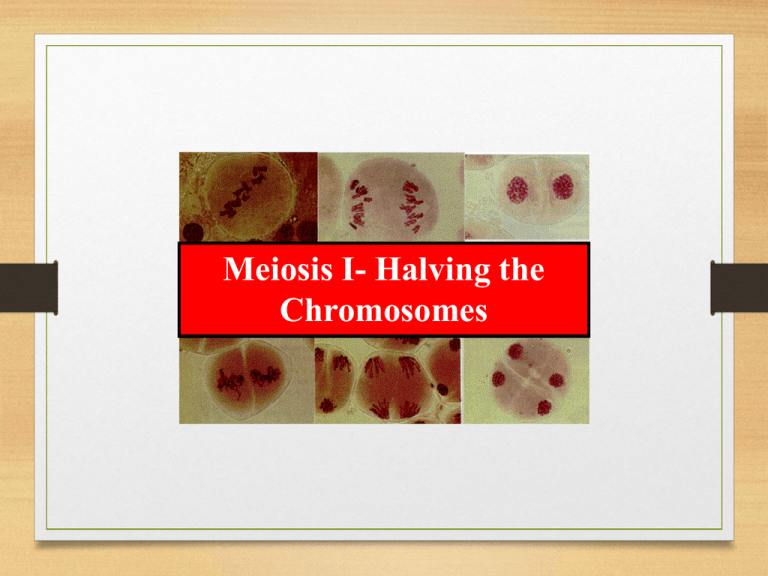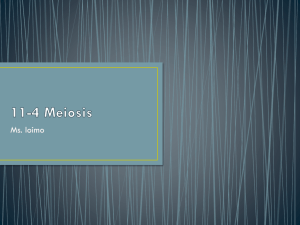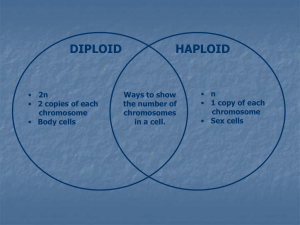File
advertisement

Meiosis I- Halving the Chromosomes Meiosis is a part of the sexual reproductive life cycle. Its purpose is to take a diploid cell (2N) and make 4 haploid (1N) cells. It is also to produce gametes with diversity. The cell divides twice - Meiosis I and Meiosis II Meiosis I The purpose of meiosis I is to take a diploid cell with double stranded chromosomes and produce two haploid cells with double stranded chromosomes and to achieve genetic diversity. Meiosis IIIt is just like mitosis but the DNA has already been replicated. It purpose is to separate double stranded chromosomes into single stranded chromosomes. DefinitionsDiploid-Having two sets of chromosomes. Advantage-hides deliterous genes. Haploid-Having one set of chromosomes. "What you see is what you get". Advantage-easier to reproduce Homologous chromosomesChromosomes that have the genes (coding for the same trait) in the same order. Interphase- G1,S,G2. DNA has been replicated. Centrosomes with centrioles repli-cate. Cetrosomes are microtubules organizing centers Prophase I- lasts longer and is more complicated then prophase of mitosis. Early prophaseChromosomes become visible as long well separated filaments. Middle prophase homologous chromosomes become thicker and shorter, and they synapse. Crossing over occurs. The 2 homologs find one another and long protein axes join the two homologs forming a tetrad. Recombination nodules (proteins) . Each nodule will clip the homologs at precisely the same place and the resulting fragments are spliced to one another forming recombined chromatids or hybrid chromatids. The point of crossing over is called a chiasma. When the two homologs are paired, they are called a tetrad. Late Prophase I The tetrad structure and chiasmata are visible. Nuclear membrane disappears. Kinetochore microtubules attach chromosomes to poles of the centrosome. In mitosis, kinetochore microtubules attach to both sides of the centromere, but in meiosis I they on attach to one side. Metaphase I- The homolgous chromosomes move as unit to the metaphase plate. The chromsomes line up on the plate two by two instead of single file. Which side of the metaphase plate, the chromosomes line up on is a matter of chance. This allows different combinations of chromosomal arrangements. The previous card shows that having two homologous pairs of chromosomes will result in 4 different gametes. The next card will show that having three homologous pairs can result in 8 different gametes. The equation for this is 2n where n is equal to the haploid number of chromosomes. Human have the possibility of making 223 different types of gametes which is why two siblings are never identical unless they are identical twins. Anaphase I-Centromeres do not split. Homologous chromosomes move apart to opposite poles. Spindle fibers from opposite poles interact to force poles apart. Two sets of homologous chromosomes are nearing poles. The resulting nuclei will become double stranded haploid cells. Telophase I- New nuclear membrane begins to form. Chormosomes become longer and thinner and as they uncoil. Cells finishing telophase I resulting in two haploid cells that have double stranded chromosomes.






